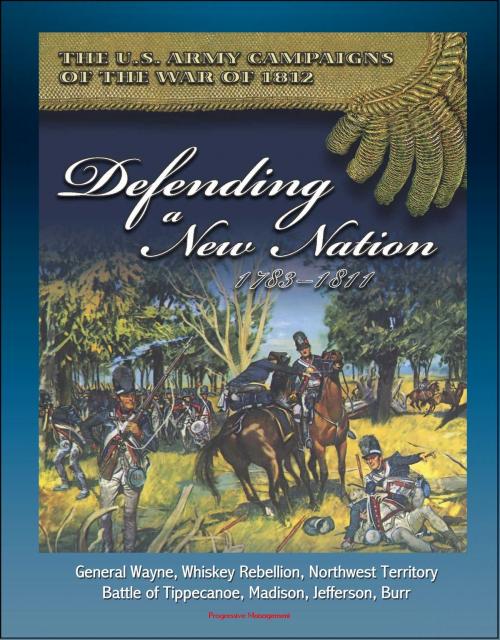The U.S. Army Campaigns of the War of 1812: Defending A New Nation, 1783-1811 - General Wayne, Whiskey Rebellion, Northwest Territory, Battle of Tippecanoe, Madison, Jefferson, Burr
Nonfiction, History, Americas, United States, 19th Century, Military| Author: | Progressive Management | ISBN: | 9781301896608 |
| Publisher: | Progressive Management | Publication: | August 3, 2013 |
| Imprint: | Smashwords Edition | Language: | English |
| Author: | Progressive Management |
| ISBN: | 9781301896608 |
| Publisher: | Progressive Management |
| Publication: | August 3, 2013 |
| Imprint: | Smashwords Edition |
| Language: | English |
The War of 1812 is perhaps the United States' least known conflict. Other than Andrew Jackson's 1815 victory at New Orleans and Francis Scott Key's poem "The Star-Spangled Banner" written in 1814 during the British attack on Baltimore, most Americans know little about the country's second major war. Its causes are still debated by historians today. Great Britain's impressment of American sailors, its seizure of American ships on the high seas, and suspected British encouragement of Indian opposition to further American settlement on the western frontier all contributed to America's decision to declare war against Great Britain in June 1812.
None of these factors, however, adequately explain why President James Madison called for a war the country was ill-prepared to wage. Moreover, the war was quite unpopular from the start. Many Federalists—chiefly in the New England states—opposed an armed conflict with Great Britain, continued to trade with the British, and even met in convention to propose secession from the Union. Some members of the president's own Republican Party objected to the war's inevitable costs and questionable objectives, such as the conquest of Canada.
To declare war was one thing, but to prosecute it successfully was a different matter. Much of the story of the War of 1812 is about the unpreparedness of America's Army and Navy at the conflict's outset, and the enormous difficulties the new nation faced in raising troops, finding competent officers, and supplying its forces. Most of America's military leaders were inexperienced and performed poorly, particularly in the first two years of war. Only gradually did better leaders rise to the top to command the more disciplined and well-trained units that America eventually fielded. But despite costly initial setbacks, by the time the fighting stopped American arms had won key victories at Chippewa, Lundy's Lane, and New Orleans under excellent officers such as Winfield Scott, Jacob Brown, and Andrew Jackson. Although the United States achieved few of its political objectives in the War of 1812, its Regular Army emerged more professional, better led, and fit to take its place as the foundation of America's national defenses.
Some of the topics and subjects covered in this engaging history: the Northwest Territory, General Wayne, Miami Indians, the Whiskey Rebellion, Fallen Timbers, William Henry Harrison, James McHenry, James Wilkinson, Presidents James Madison and Thomas Jefferson, the Battle of Tippecanoe, Henry Dearborn, Lewis and Clark, and Aaron Burr.
All Army leaders and soldiers are encouraged to read this. We can all profit from greater knowledge about the beginnings of our Army: an Army forged in victory and defeat during what has often been called the second war of American independence.
The War of 1812 is perhaps the United States' least known conflict. Other than Andrew Jackson's 1815 victory at New Orleans and Francis Scott Key's poem "The Star-Spangled Banner" written in 1814 during the British attack on Baltimore, most Americans know little about the country's second major war. Its causes are still debated by historians today. Great Britain's impressment of American sailors, its seizure of American ships on the high seas, and suspected British encouragement of Indian opposition to further American settlement on the western frontier all contributed to America's decision to declare war against Great Britain in June 1812.
None of these factors, however, adequately explain why President James Madison called for a war the country was ill-prepared to wage. Moreover, the war was quite unpopular from the start. Many Federalists—chiefly in the New England states—opposed an armed conflict with Great Britain, continued to trade with the British, and even met in convention to propose secession from the Union. Some members of the president's own Republican Party objected to the war's inevitable costs and questionable objectives, such as the conquest of Canada.
To declare war was one thing, but to prosecute it successfully was a different matter. Much of the story of the War of 1812 is about the unpreparedness of America's Army and Navy at the conflict's outset, and the enormous difficulties the new nation faced in raising troops, finding competent officers, and supplying its forces. Most of America's military leaders were inexperienced and performed poorly, particularly in the first two years of war. Only gradually did better leaders rise to the top to command the more disciplined and well-trained units that America eventually fielded. But despite costly initial setbacks, by the time the fighting stopped American arms had won key victories at Chippewa, Lundy's Lane, and New Orleans under excellent officers such as Winfield Scott, Jacob Brown, and Andrew Jackson. Although the United States achieved few of its political objectives in the War of 1812, its Regular Army emerged more professional, better led, and fit to take its place as the foundation of America's national defenses.
Some of the topics and subjects covered in this engaging history: the Northwest Territory, General Wayne, Miami Indians, the Whiskey Rebellion, Fallen Timbers, William Henry Harrison, James McHenry, James Wilkinson, Presidents James Madison and Thomas Jefferson, the Battle of Tippecanoe, Henry Dearborn, Lewis and Clark, and Aaron Burr.
All Army leaders and soldiers are encouraged to read this. We can all profit from greater knowledge about the beginnings of our Army: an Army forged in victory and defeat during what has often been called the second war of American independence.















